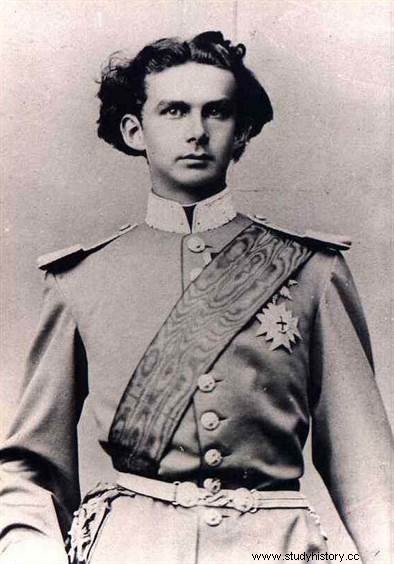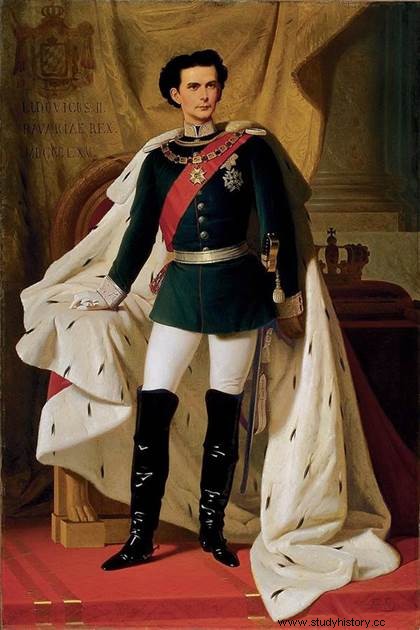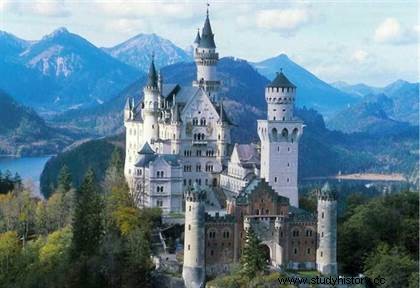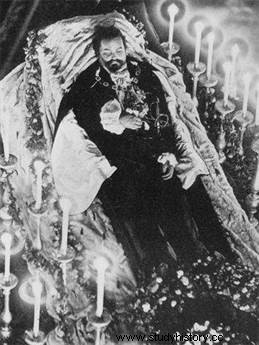 Dreamy Child, Ludwig II of Bavaria remained so all his life, even when he became king at the age of 18 in March 1864, on the death of his father, the sovereign-philosopher Maximilian II, the "Bavarian Marcus Aurelius". The reign could then begin. King patron first, protector of Wagner and Kainz, Ludwig II was also a builder king, castles which often revealed - especially was this the case of Neuschwanstein - his atypical character. After the good fortune that Ludwig II kept looking for, the misfortune that occurred in June 1886, with a death that has not ceased, until today, to cause a lot of ink to flow.
Dreamy Child, Ludwig II of Bavaria remained so all his life, even when he became king at the age of 18 in March 1864, on the death of his father, the sovereign-philosopher Maximilian II, the "Bavarian Marcus Aurelius". The reign could then begin. King patron first, protector of Wagner and Kainz, Ludwig II was also a builder king, castles which often revealed - especially was this the case of Neuschwanstein - his atypical character. After the good fortune that Ludwig II kept looking for, the misfortune that occurred in June 1886, with a death that has not ceased, until today, to cause a lot of ink to flow.
Childhood of Ludwig II of Bavaria
Relatively bad was the education he received, this Bavarian child born August 25, 1845 at Nymphenburg Castle, near Munich. However, efforts had been made. Hadn't he been given Ignace de Doellinger as his tutor and the famous chemist Liebig as his teacher? As a young man, Ludwig II had been a great reader. The readings allowed him to penetrate new and marvelous worlds where he was a fully-fledged actor. It was in search of this same state of reverie that the king set out, taking an interest in a painting, a sculpture, a construction, music.  Bainville writes that"the simulacrum of a beautiful painting was enough for him, just as he contented, in default of precious stones, with colored glasses. Not being rich enough to have columns of porphyry or lapis lazuli, imitations of stucco gave him the same pleasure”. Louis preferred form to substance, he also sought emotion. Emotion that he rediscovered several times and very intensely while listening to Wagner. The musical encounter had taken place in 1861, when Louis was only sixteen years old. He had been dazzled by a performance of Lohengrin and, therefore, had taken it into his head to seek out the composer, which was done in May 1864 when the secretary of the new king, M. de Pfistermeister, had convinced Wagner to settle near the king.
Bainville writes that"the simulacrum of a beautiful painting was enough for him, just as he contented, in default of precious stones, with colored glasses. Not being rich enough to have columns of porphyry or lapis lazuli, imitations of stucco gave him the same pleasure”. Louis preferred form to substance, he also sought emotion. Emotion that he rediscovered several times and very intensely while listening to Wagner. The musical encounter had taken place in 1861, when Louis was only sixteen years old. He had been dazzled by a performance of Lohengrin and, therefore, had taken it into his head to seek out the composer, which was done in May 1864 when the secretary of the new king, M. de Pfistermeister, had convinced Wagner to settle near the king.
If he was not unknown, the composer was no less unknown. However, some saw him as a genius, but a genius whose recognition was long overdue. A friendship began, punctuated by sulphurous epistolary exchanges. Like his grandfather Ludwig I, who had had trouble with the people because of his relationship with the courtesan Lola Montès, Ludwig II had to force himself to separate from Richard Wagner, the people of Munich imputing Ludwig II's expenses to the latter. . The friendship that had united the two characters was about to end. The proof is:was the king not absent at Wagner's funeral in February 1883?
From king to patron
From the start of his reign, Ludwig II was confronted with the rise of Prussia and its ambitious chancellor, Bismarck. In 1866, he supported Austria at war with Prussia. Bad choice, his Habsburg ally is beaten at Sadowa. During the Franco-German war of 1870-71, he weakly supported victorious Prussia, which proclaimed the Empire in the Hall of Mirrors at Versailles, which resulted in the end of Bavaria's independence. Taking no interest in state affairs, Ludwig II then devoted himself to arts and culture, and in particular to his castle projects.
King patron, like all the kings of the House of Wittelsbach, Ludwig II of Bavaria had therefore made Munich a musical capital, just as his grandfather had made one artistic capital. Limited musical capital however, Bayreuth supplanting it after the departure of Wagner. It is well known, when one loves, one does not count. And Louis' lavishness to those he loved, if only for their art, was significant.
 It was, finally, the same for Joseph Kainz, actor of the Jewish faith whom Ludwig II had greatly appreciated in the role of Didier in April 1881 during a performance of Marion Delorme by Victor Hugo. The epistolary relationship between the king and the actor was almost as feverish as that between the king and the composer Wagner a few years earlier. But their friendship soon ended:during a night walk Ludwig II asked the actor to recite Schiller, which Kainz refused. It didn't take long for their friendship to end.
It was, finally, the same for Joseph Kainz, actor of the Jewish faith whom Ludwig II had greatly appreciated in the role of Didier in April 1881 during a performance of Marion Delorme by Victor Hugo. The epistolary relationship between the king and the actor was almost as feverish as that between the king and the composer Wagner a few years earlier. But their friendship soon ended:during a night walk Ludwig II asked the actor to recite Schiller, which Kainz refused. It didn't take long for their friendship to end.
Ludwig II of Bavaria, King Builder
Strange was the architectural construction of King Ludwig II. The Bavarian was starting new projects while the old ones were not yet finished. Above all, the castles, such as that of Herrenchiemsee, an imperfect copy of the French Versailles that Louis II had visited with pleasure (he had been inspired by it in particular to reproduce a long hall of mirrors), were very expensive, which contributed to attenuating the King's popularity. In Neuschwanstein, the first stone of which was laid by the architect Jank in 1869, Ludwig II left one floor completely empty and some have claimed that it was in case he married one day. Bainville writes that "Neuschwanstein begins to reveal to us the nature of Ludwig II's cerebral disorder" . It has been said that this splendor of Romanesque and Gothic inspiration inspired Walt Disney for its logo.
These are, in fact, in a sumptuous setting, only gigantic spaces for a single man. Finally, the sovereign again showed a desire to imitate Louis XIV by building the castle of Linderhof, which he did not hesitate to rename, from the name of the neighboring village of Ettal, "Meitcost-Ettal", clumsy anagram of "L'Etat, c'est moi", a famous apocryphal phrase that the King of France Louis XIV obviously never uttered on April 13, 1655.
June 13, 1886:a tragic end
 In the grip of appalling physical pain, the King of Bavaria had to face Munich's disputes concerning budgetary excesses. Taking advantage of these, Prince Luitpold took in fine power by a coup d'etat, and hastened to declare Ludwig II insane and therefore incapable of exercising power. Fallen king, Louis II knew that a plot was being hatched against him. He could have taken refuge abroad – in particular in Austria – but did not do so. Perhaps he thought it too dishonorable. Captured and placed in internment in the castle of Berg (June 11, 1886), he walked daily but was necessarily and obligatorily accompanied. On the 13th, Dr. Gudden accompanied the king. After a long time, we noticed that they did not reappear and we soon went looking for them.
In the grip of appalling physical pain, the King of Bavaria had to face Munich's disputes concerning budgetary excesses. Taking advantage of these, Prince Luitpold took in fine power by a coup d'etat, and hastened to declare Ludwig II insane and therefore incapable of exercising power. Fallen king, Louis II knew that a plot was being hatched against him. He could have taken refuge abroad – in particular in Austria – but did not do so. Perhaps he thought it too dishonorable. Captured and placed in internment in the castle of Berg (June 11, 1886), he walked daily but was necessarily and obligatorily accompanied. On the 13th, Dr. Gudden accompanied the king. After a long time, we noticed that they did not reappear and we soon went looking for them.
The king's body was finally discovered in Lake Starnberg. Same for Dr. Gudden's body. They would have fought in the water and the king, more corpulent (tall – 1m90 – and fat due to his excesses in food) than his adversary, would have killed him by drowning him. The doctor's face was indeed covered with blows, surely given by the king with the help of his telescope which he had got into the habit of always keeping on him. The official report of the events said that the king, after killing Gudden, killed himself by drowning himself on purpose. But the water was not deep enough for that where the king's body had been found. For Bainville, the king would have fled and an individual, on the bank, would have shot him from a distance. There is, ultimately, a common point of the death and the living of the Bavarian sovereign:in one as in the other, the king remains mysterious.
Bibliography
- BAINVILLE Jacques, Ludwig II of Bavaria. Bartillat, 2009.
- Ludwig II of Bavaria:The Throne and Madness, by Catherine Decours. Fayard, 2019.
- DES CARS Jean, Ludwig II of Bavaria:Or the thunderstruck king, Tempus, 2010.
To go further
- Ludwig or the Twilight of the Gods (1973), film by Luchino Visconti.
